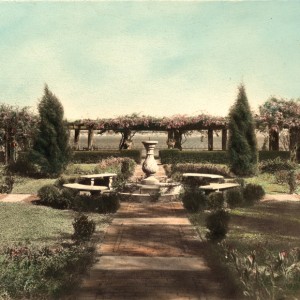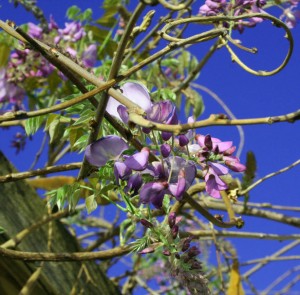Wisteria floribunda, commonly known as Japanese wisteria, is often found flourishing in the English and Olmsted Gardens in early- to mid-spring. The Japanese wisteria produces the lengthiest racemes of any wisteria, making it a truly unique asset to the Gardens. In moist soil and full sun, this species of flowering plant can grow up to 30 feet and survive over 50 years, weaving and climbing around the arbors overlooking the St. Johns River.  The large wisteria arbor in the English Garden was built in 1910, when Mr. and Mrs. Cummer decided they needed a new infusion of advice as well as additional trees and shrubs for their grounds. They looked to an out-of-state resource, the Philadelphia nurserymen, Thomas Meehan (1826 – 1901) and Sons to bring their centerpiece to life. Mrs. Cummer’s notation on Meehan’s plan indicates that she originally called it the Wisteria Garden, but in later years it was referred to as the Azalea Garden. Today it is known as the English Garden. Family snapshots taken within a year of Meehan’s installation show the same basic design configuration that exists today – rectangular, with beautifully-laid brick paths, and Japanese wisteria entwining the cypress-beamed pergola.
The large wisteria arbor in the English Garden was built in 1910, when Mr. and Mrs. Cummer decided they needed a new infusion of advice as well as additional trees and shrubs for their grounds. They looked to an out-of-state resource, the Philadelphia nurserymen, Thomas Meehan (1826 – 1901) and Sons to bring their centerpiece to life. Mrs. Cummer’s notation on Meehan’s plan indicates that she originally called it the Wisteria Garden, but in later years it was referred to as the Azalea Garden. Today it is known as the English Garden. Family snapshots taken within a year of Meehan’s installation show the same basic design configuration that exists today – rectangular, with beautifully-laid brick paths, and Japanese wisteria entwining the cypress-beamed pergola.
Wisteria Floribunda (Japanese wisteria) and the English Garden
by Amber Sesnick, Marketing Manager in Education
Mar
25
Post Author
This post was written by Amber Sesnick who has written 345 posts on The Cummer Museum of Art & Gardens.
Marketing Manager
Sign Up for our email Newsletter
Categories
- Art
- Behind the Scenes
- Community
- Cummer Amelia
- Cummer Beaches
- Cummer CAFÉ
- Cummer SHOP
- Education
- Gardens
- Podcast
- Programs
- Support
Connect with Us
Keep up with us on Facebook and Twitter to see what we're doing on other parts of the web!
Leave Us A Review
Did you have a great experience at The Cummer Museum & Gardens or the Tree Cup Cafe? Write a review or leave a fun tip on Yelp, TripAdvisor or FourSquare.
@thecummermuseum On Twitter
Recent Tweets
- Don’t miss a FREE recital from two members of the Ritz Chamber Players! ow.ly/Wh4L9 https://t.co/9BuWi2pVLI 8 years ago
- Need to get out of the house? Pay a visit to “The Newcomb Pottery Enterprise”. The show closes January 3rd! 8 years ago
- We love our Docents! Thank you Susan Law for your hard work! ow.ly/Wh3Jw 8 years ago
- Did you see the Folio Weekly article on the Outings Project? ow.ly/W2JxS 8 years ago
- #TBT to last month when Julien de Casabianca was in Jacksonville for the Outings Project! ow.ly/VYDBS 8 years ago
Powered by Tools for Twitter



